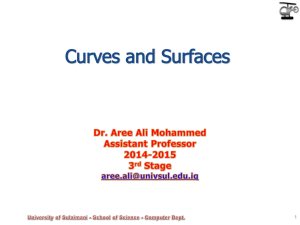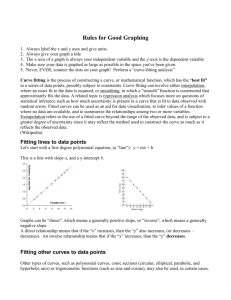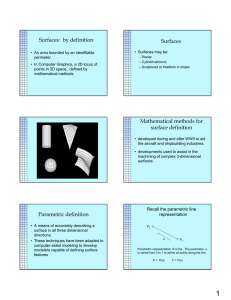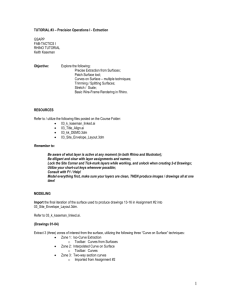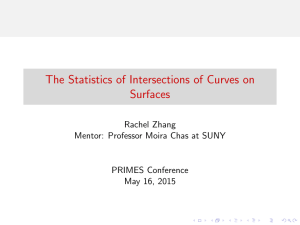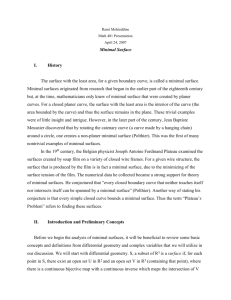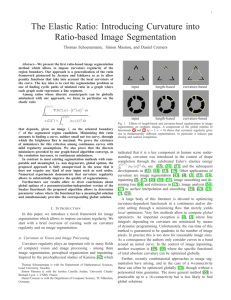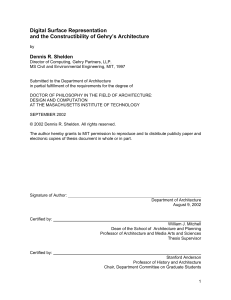day08c
advertisement
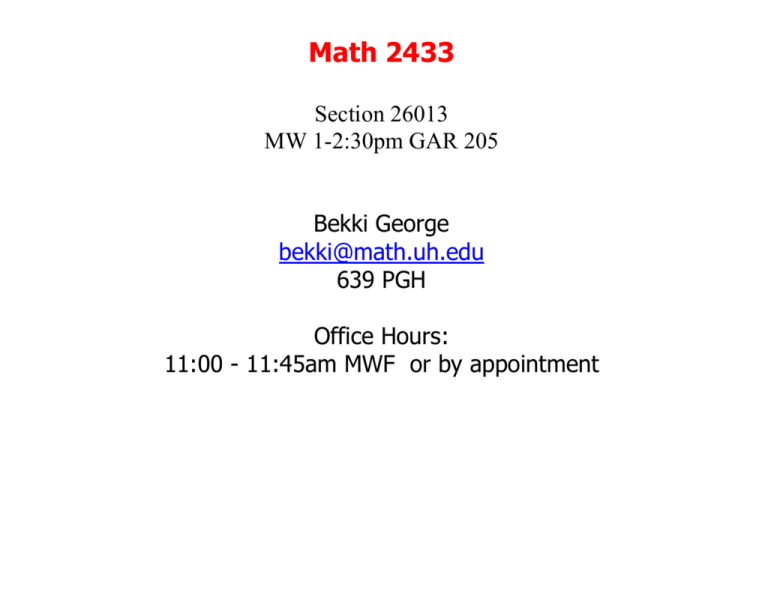
Math 2433
Section 26013
MW 1-2:30pm GAR 205
Bekki George
bekki@math.uh.edu
639 PGH
Office Hours:
11:00 - 11:45am MWF or by appointment
Class webpage:
http://www.math.uh.edu/~bekki/Math2433.html
Quiz due dates and sections covered are now posted on class
webpage!
13.5 Curvilinear Motion; Curvature
Formulas in this section:
Examples:
1.Find the curvature of the given curve: y = ln(sec(x))
2.Interpret r(t) as the position of a moving object at time t. Find the
curvature of the path and determine the tangential and normal
components of acceleration .
r (t ) cos(t )i tj sin(t )k
æp ö
3. Find the curvature and radius of curvature for y = 2sin(2x) at çè 12 ,1÷ø
Popper05
1.Which of the following is equal to speed ?
ds
a. dt
b. r ¢(t)
2
2
2
x'(t)
+
y'(t)
+
z'(t)
(
)
(
)
(
)
c.
d. both a and b
e. a, b and c
f. none of these
Last week: Vector Functions ex: f(t) = x(t) i + y(t) j + z(t) k
This week: Real valued functions (not vectors)
ex: f (x), f (x, y), f (x, y,z)
14.1 Examples of real-valued functions of two and three variables
(read this section!!)
Finding domain and range:
1. f (x, y) = xy
1
2. f (x, y) = x - y
3.
4.
f ( x, y ) 9 x 2 4 y 2
f (x, y, z) =
z
x2 - y2
Popper05
2.Find the domain of the given function:
f (x, y) =
1
y - 5x 2
a) {(x, y)| y < 5x2}
b) {(x, y)| y > 5x2}
d) {(x, y)| y < 5x2}
e) {(x, y)| y > 5x2}
c) {(x, y)| y ≠ 5x2}
14.2 The Quadric Surfaces and Projections
(Note: Sections 9.1-9.2 review of conic sections)
The quadric surfaces are surfaces that can be written in the form:
Ax 2 By 2 Cz 2 Dxy Exz Fyz Hx Iy Jz K 0
where A, B,C,..., K are constants.
There are nine distinct types (see book for all 9 and examples). These are
important, so get familiar with them.
Projections:
Suppose you have two surfaces that intersect
in a space curve C.
The curve C is the set of all (x, y, z) such that z = f(x, y)
and z = g(x, y) and so the set of all points (x, y, z) such
that f(x, y) = g(x, y) create a vertical cylinder through C.
If we find all the points (x, y, 0) where f(x, y) = g(x, y) then
we have a projection of C onto the xy-plane.
Example:
1. Determine the projection onto the xy-plane: y 2 + z - 4 = 0 & x 2 + 3y 2 = z
3
2
2
2
x
+
y
+
(z
-1)
=
x 2 + y 2 - z 2 = 1 intersect in
2. A sphere
and
the
hyperboloid
2
a space curve C. Determine the projection of C onto the xy-plane.
Popper05
3. E
4. The surfaces intersect in a space curve C. Determine the projection of C
onto the xy-plane.
and
a)
b)
d)
e)
c)
14.3 Level Curves and Level Surfaces
Look over book examples!!!
When we talk about the graph of a function with two variables defined on a
subset D of the xy-plane, we mean:
z = f (x, y)
( x, y ) ÎD
If c is a value in the range of f then we can sketch the curve f(x,y) = c.
This is called a level curve.
A collection of level curves can give a good representation of the 3-d
graph.
Examples:
Identify the level curves f (x, y) = c and sketch the curves corresponding to
the indicated values of c.
2
2
f
(
x
,
y
)
x
y
1.
x
y
2.Identify the level curves:
2
f
(
x
,
y
)
ln(
x
y
)
a.
( x2 2 y 2 )
b. f ( x, y) e
3.Identify the c-level surface and sketch it.
f ( x, y, z ) 4 x 2 9 y 2 72 z
c0
Popper05
2
f
(x,
y)
=
ln(y
+
2x
)
5. Identify the level curves for:
a. parabolas
b. ellipses
c. hyperbolas
d. lines
e. none of these
Partial Derivatives (parts from 14.4 and 14.6)
The partial derivative of f with respect to x is the function fx obtained by
differentiating
f with respect to x, treating y as a constant.
The partial derivative of f with respect to y is the function fy obtained by
differentiating
f with respect to y, treating x as a constant.
Examples:
Find the partial derivatives:
2
f
(
x
,
y
)
3
x
2 y xy
1.
2.
2
æ x ö
f (x, y) = ex+ y + ln ç 2
è x + y ÷ø
3.
f ( x, y , z ) 3 x 2 z e y z x 2 y 2
Higher order derivatives:
Example: Find all second partials for:
In the case of a function of three variables you can look for three first
partials f x , f y , f z and there are NINE second partials:
f xy , f yx , f xz , f zx , f yz , f zy , f xx , f yy , f zz
Examples: Find all first and second partial derivatives:
1.
2
2
2
f
(
x
,
y
,
z
)
x
y
y
z
z
x
2.

